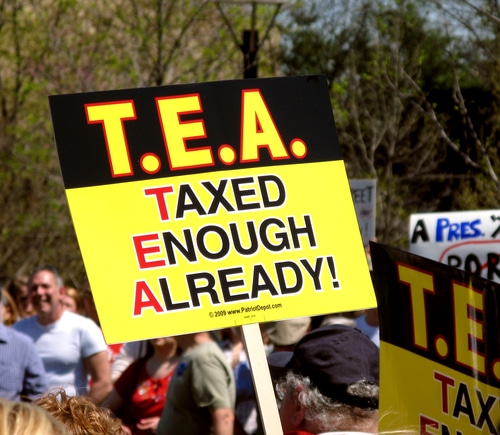Climate change doubt is a key belief in the TEA Party, sparked by the Koch-related Americans for Prosperity and FreedomWorks. Big Tobacco was heavily involved from the 1980s onward, and by 1992 the “Tea Party” was already in play. Extensive new research has unearthed the real history.
“‘To quarterback behind the scenes, third-party efforts’: the tobacco industry and the Tea Party” by Amanda Fallin, Rachel Grana and Stanton A Glantz, was published online last week in BMJ Tobacco Control, a high-impact peer-reviewed journal. They write:
“Rather than being a purely grassroots movement that spontaneously developed in 2009, the Tea Party has developed over time, in part through decades of work by the tobacco industry and other corporate interests.”
“Starting in the 1980s, tobacco companies worked to create the appearance of broad opposition to tobacco control policies by attempting to create a grassroots smokers’ rights movement. Simultaneously, they funded and worked through third-party groups, such as Citizens for a Sound Economy, the predecessor of AFP and FreedomWorks, to accomplish their economic and political agenda. There has been continuity of some key players, strategies and messages from these groups to Tea Party organisations. As of 2012, the Tea Party was beginning to spread internationally.”
Watch the 19 minute video from Friday, starting at 01:17:45: “Quarterbacking Behind the Scenes” The Tobacco Industry and the Tea Party,” read the blog by Glantz, then buy the paper for the extensive backup detail.* It’s worth it, but the paper is now free. Their title came from a 1995 Philip Morris strategy memo by Beverly McKittrick:
‘A. Long-term – To create political environment where “moderates” of both parties can vote for legislation that divests FDA of any power to regulate tobacco because they are convinced that FDA is already failing miserably in accomplishing its “core mission.”
B. Short-term – To quarterback behind the scenes, third-party efforts to launch, publicize and execute a broad non-tobacco-based attack on the many failings of the FDA with respect to its currently authorized statutory activities.
II. THIRD–PARTY GROUPS
A. Citizens for a Sound Economy – Monitor and help direct multi-front action plan.
B. Washington Legal Foundation – Monitor and help direct multi-front action plan
C. Competitive Enterprise Institute – Work with Borelli to help tie their activities more into congressional efforts re timing, focus, and venues….’
CEI‘s well-known efforts in climate anti-science feature Myron Ebell, Chris Horner, their Cooler Heads Coalition, and their role in recruiting Ross McKitrick, Christopher Essex and Steve McIntyre in the attack on the hockey-stick temperature curve, but CEI had a long involvement with tobacco:
“On behalf of everyone here at the Competitive Enterprise Institute, I would like to thank you for Philip Morris’s $150,000 contribution. … Fred L. Smith, Jr, President”
However, CSE was tobacco’s favorite, taking at least $5.3M 1991-2002. It was founded in 1984 by David Koch and his key lieutenant, Richard Fink, ex-economics professor at George Mason University (GMU), home of the Mercatus Center, the Institute for Humane Studies and law school that graduated Ken Cuccinelli and other relevant lawyers. CSE Exec VP and first AFP President Nancy Mitchell Pfotenhauer was a GMU student, major Koch lobbyist for years, and lately Vice-Rector of GMU (A.5, A.6). CSE later reorganized into TEA Party sparkplugs Americans For Prosperity and FreedomWorks.
The tobacco/climate anti-science relationship was highlighted in Merchants of Doubt and has been noted by others. Tobacco interests created many of the tactics and fostered the machinery inherited by other anti-science efforts. Here at DeSMogBlog Fakery 2: More Funny Finances, Free oF Tax, Appendix F, showed the crucial problem for tobacco companies. As per RJ Reynolds’ The Importance of Younger Adults, they needed to addict children to create lifelong customers, not adults. Few start smoking after age 18, and later starters find it easier to quit, because addiction really is best entrenched while brains are still developing.
Higher cigarette taxes especially deter children from smoking, so they pose an existential threat to tobacco companies, to be fought at all costs, but hidden among larger groups. As Fallin, Grana and Glantz wrote,
“In 1990, Tim Hyde, RJR director of national field operations, outlined a strategy for RJR to create ‘a movement’ resembling what would later emerge as the Tea Party by
‘build[ing] broad coalitions around the issue-cluster of freedom, choice and privacy…’
Another RJR field coordinator later described the company’s motivation for involving and organising third-party organisations:
‘…—anti-tax groups were a natural. You didn’t have to defend your position on tobacco because a tax is a tax is a tax to these guys.’”
The authors found an even more specific Burson-Marsteller proposal from 1992:
“Grounded in the theme of “The New American Tax Revolution” or The New Boston Tea Party,” the campaign activity should take the form of citizens representing the widest constituency base mobilized with signage and other attention-drawing accoutrements such as lapel buttons, handouts, petitions and even costumes.”
It took decades, but they got that, including the costumes. I’d guess few members of the TEA Party realize it was created to help the tobacco industry addict kids to behavior that will kill many, slowly. For a definitive history of tobacco industry malfeasance, there is no better source than Golden Holocaust: Origins of the Cigarette Catastrophe and the Case for Abolition (2012).
Side-by-side with Kochs, expanding abroad, TEA = Tobacco Everywhere Always.
See also Brendan’s take on this, Study Confirms Tea Party Was Created by Big Tobacco and Billionaires.
* This article has 184 footnotes with references to many more details, plus another 16 pages of dense supplementary material listing organizations, people, funding, campaign examples, with its own 161 footnotes. In my opinion, it is an investigative tour de force, costs $30 and is worth every penny.
UPDATE 02/22/13: paper is now freely available.
Update 07/10/16: tweak wording to clarify link to free paper.
Image credit: R. Gino Santa Maria / Shutterstock.com
Subscribe to our newsletter
Stay up to date with DeSmog news and alerts







